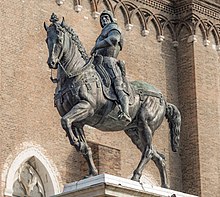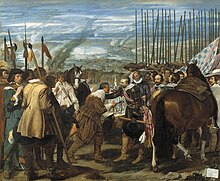Condottiero

Condottieri (Italian:
The term "condottiero" in
Mercenary captains
Background
In the thirteenth and fourteenth centuries, the Italian city-states of Venice, Florence, and Genoa were very rich from their trade with the Levant, yet possessed woefully small armies. In the event that foreign powers and envious neighbours attacked, the ruling nobles hired foreign mercenaries to fight for them. The military-service terms and conditions were stipulated in a condotta (contract) between the city-state and the soldiers (officer and enlisted man), thus, the contracted leader, the mercenary captain commanding, was titled the Condottiere.
From the eleventh to the thirteenth century, European soldiers led by professional officers fought against the
Rise
The first mercenary company with an Italian as its chief was the "Company of St. George" formed in 1339 and led by
Once aware of their military power monopoly in Italy, the condottieri bands became notorious for their capriciousness and soon dictated terms to their ostensible employers. In turn, many condottieri, such as Braccio da Montone and Muzio Sforza, became powerful politicians. As most were educated men acquainted with Roman military science manuals (e.g. Vegetius's Epitoma rei militarii), they began viewing warfare from the perspective of military science, rather than as a matter of valour or physical courage—a great, consequential departure from chivalry, the traditional medieval model of soldiering. Consequently, the condottieri fought by outmanoeuvring the opponent and fighting his ability to wage war, rather than risking uncertain fortune—defeat, capture, death—in battlefield combat.

The earlier, medieval condottieri developed the "art of war" (
In 1347,

From the fifteenth century hence, most condottieri were landless Italian nobles who had chosen the profession of arms as a livelihood; the most famous of such mercenary captains was the son of
- 1,900 monthly florins in 1432: Micheletto Attendolo(Florence)
- 6,600 monthly florins in 1448: Francesco Sforza(Milan); the enlisted soldier's pay was 3,300 florins, half that of an officer's
- 33,000 yearly Francesco II Gonzaga(Florence)
- 100,000 yearly scudi for 200 men in 1505: Francesco Maria I della Rovere (Florence)
The condottieri company commanders selected the soldiers to enlist; the condotta was a consolidated contract, and, when the ferma (service period) elapsed, the company entered an aspetto (wait) period, wherein the contracting city-state considered its renewal. If the condotta expired definitively, the condottiere could not declare war against the contracting city-state for two years. This military–business custom was respected because professional reputation (business credibility) was everything to the condottieri; a deceived employer was a reputation ruined; likewise, for maritime mercenaries, whose contratto d'assento (contract of assent) stipulated naval military-service terms and conditions; sea captains and sailors so-contracted were called assentisti. Their principal employers were Genoa and the Papal States, beginning in the fourteenth century, yet Venice considered it humiliating to so employ military sailors, and did not use naval mercenaries, even during the greatest danger in the city's history.
In fifteenth-century Italy, the condottieri were masterful lords of war; during the wars in Lombardy, Machiavelli observed:
None of the principal states were armed with their own proper forces. Thus the arms of Italy were either in the hands of the lesser princes, or of men who possessed no state; for the minor princes did not adopt the practice of arms from any desire of glory, but for the acquisition of either property or safety. The others (those who possessed no state) being bred to arms from their infancy, were acquainted with no other art, and pursued war for emolument, or to confer honour upon themselves.
— History I. vii.
In 1487, at
Decline

In time, the financial and political interests of the condottieri proved serious drawbacks to decisive, bloody warfare: the mercenary captains often were treacherous, tending to avoid combat, and "resolve" fights with a bribe—either for the opponent or for themselves.[citation needed] Towards the end of the 15th century, when the large cities had gradually swallowed up the small states, and Italy itself was drawn into the general current of European politics, and became the battlefield of powerful armies—French, Spanish and German—the venture captains, who in the end proved quite unequal to the gendarmerie of France and the improved troops of the Italian states, gradually disappeared.
The soldiers of the condottieri were almost entirely heavy armoured cavalry (men-at-arms). Before 1400, they had little or nothing in common with the people among whom they fought, and their disorderly conduct and rapacity seem often to have exceeded that of medieval armies. They were always ready to change sides at the prospect of higher pay—the enemy of today might be the comrade-in-arms of tomorrow. Further, a prisoner was always more valuable than a dead enemy. As a consequence, their battles were often as bloodless as they were theatrical.
The age of firearms and weapons utilizing gunpowder further contributed to the decline of the condottieri. Although the mercenary forces were among the first to adapt to the emerging technologies on the battlefield,[citation needed] ultimately, the advent of firearms-governed warfare rendered their ceremonial fighting style obsolete. When battlefields shifted from chivalric confrontations characterized by ostentatious displays of power to an everyman's war, they were ill-prepared to adjust.
Captain generals
In 1494, the French king
The end of the
List



- Roger de Flor (c. 1268–1305)
- Malatesta da Verucchio (1212–1312)
- Castruccio Castracani, Lord of Lucca(1281–1328)
- Cangrande della Scala(1291–1329)
- Montréal d'Albarno(c. 1315–1354)
- Walter VI of Brienne(c. 1304–1356)
- Konrad von Landau (died 22 April 1363)
- Albert Sterz (executed 1366)
- John Hawkwood (Giovanni Acuto, c. 1320–1394)
- Giovanni Ordelaffi from Forlì (1355–1399)
- Astorre I Manfredi (1345–1405)
- Alberico da Barbiano (1344–1409)
- Johann II (Habsburg-Laufenburg) (c. 1330–1380)
- Facino Cane de Casale (c. 1360–1412)
- Angelo Broglio da Lavello, also known as Tartaglia (1350 or 1370–1421)
- Andrea Fortebracci, better known as Braccio da Montone (1368–1424)
- Sforza(Strong) (1369–1424)
- Francesco Bussone da Carmagnola (1390–1432)
- Giovanni Vitelleschi (d. 1440)
- Erasmo da Narni, also known as Gattamelata (1370–1443)
- Niccolò Piccinino (1380–1444)
- Micheletto Attendolo (Muzio Attendolo's cousin or nephew, c. 1390–c. 1451)
- Francesco Sforza(1401–1466)
- Onorata Rodiani (1403–1452)
- Sigismondo Pandolfo Malatesta (1417–1468)
- Bartolomeo Colleoni (c. 1400–1475)
- Federico III da Montefeltro(1422–1482)
- Francesco Alidosi (1455–1511)
- Vitellozzo Vitelli (1458–1502)
- Oliverotto Euffreducci (1475–1502)
- Niccolò di Pitigliano (d. 1510)
- Ettore Fieramosca (1479–1515)
- Cesare Borgia (1475–1507)
- Prospero Colonna (1452–1523)
- Bartolomeo d'Alviano (1455–1515)
- Gian Giacomo Trivulzio (c. 1441–1518)
- Piero Strozzi (1510–1558)
- Andrea Doria (1466–1560)
- Marquis of Pescara(1489–1525)
- Marquis of Vasto(1502–1546)
- Giovanni dalle Bande Nere(1498–1526)
- Ferrante Gonzaga (1507–1557)
- Alexander Farnese (1545–1592)
- Torquato Conti (1591–1636)
- Ambrogio Spinola (1569–1630)
- Ottavio Piccolomini (1599–1656)
- Raimondo Montecuccoli (1609–1680)
Principal battles
- Battle of Montecatini (1315)
- Battle of Parabiago (1339) – Lodrisio Visconti's "Company of St. George", for Verona, against Luchino Visconti and Ettore da Panigo for Milan
- Battle of Cascina (1364)
- War of the Eight Saints (1375–1378)
- Breton mercenaries under John Hawkwood slaughtered more than 2,000 citizens of Cesena
- Padova
- Muzio Attendoloand others for the Bolognese-Florentine league
- Battle of Motta (1412)
- Battle of Sant'Egidio (1416) – Braccio da Montone, for himself, against Carlo I Malatesta, for Perugia
- Battle of Maclodio (1427) – Count of Carmagnola, for Venice, against Carlo I Malatesta, for Milan
- Battle of San Romano (1432) – Niccolò da Tolentino, for Florence, against Francesco Piccinino, for Siena
- Battle of Anghiari (1440) – Niccolò Piccinino, for Milan, against Florence, Papal States and Venice, under Micheletto Attendolo
- Battle of Bosco Marengo (1447)
- Battle of Molinella (1467)
- Battle of Crevola (1487)
- Italian League against Charles VIII of France
- Battle of Agnadello (1509) – Bartolomeo d'Alviano, for Venice, against France and the Italian League
- Battle of Marciano (1554) – Gian Giacomo Medici for Florence and the Holy Roman Empire against Piero Strozzi for Siena and France
- Fall of Antwerp (1585) – Alexander Farnese for Catholic Spain against Dutch Protestants and England
- Siege of Paris (1590) – Alexander Farnese for the Catholic League against Royal France, England and the Huguenots
- Electorate of Palatinate
- The Duchy of Parma
References
- ^ Tomassini, Luciano; storico, Italy Esercito Corpo di stato maggiore Ufficio (1978). Raimondo Montecuccoli: capitano e scrittore (in Italian). Stato Maggiore dell'esercito, Ufficio storico.
- ^ Pronti, Stefano; civici, Piacenza (Italy) Musei (1995). Alessandro Farnese: condottiero e duca (1545–1592) (in Italian). TipLeCo.
- ^ Lenman, B., Anderson, T. Chambers Dictionary of World History, p. 200
- ISBN 9781349200894.
- ISBN 9780307476661.
- ISBN 1593083289.
- ^ Mallett 1974, p. 6.
Sources
- Machiavelli, Niccolò. History of Florence. book I, ch. vii.(on-line text)
- Rendina, Claudio (1992). I Capitani di ventura. Newton Compton.
- Ricotti, Ercole (1844–1845). Storia delle compagnie di ventura in Italia, 4 vols.
- Lenman, B., Anderson, T., eds. (2000). Chambers Dictionary of World History, Edinburgh: Chambers Harrap Publishers Ltd., ISBN 0-550-13000-4
- Mallett, Michael (1974). Mercenaries and their Masters: Warfare in Renaissance Italy. London: The Bodley Head. ISBN 0-370-10502-8.
- Димов, Г. Войната в италийските земи през късното Средновековие: кондотиерите – В: сп. Алманах, I, 2015, 30–43.
- This article incorporates text from a publication now in the public domain: Chisholm, Hugh, ed. (1911). "Condottiere". Encyclopædia Britannica. Vol. 6 (11th ed.). Cambridge University Press. pp. 854–855..,
External links
 Media related to Condottieri at Wikimedia Commons
Media related to Condottieri at Wikimedia Commons- Adrian Fletcher's Paradoxplace Condottieri Statues & Paintings (in English)
- Condottieri di ventura – a complete database about Condottieri operating in Italy between 1300–1550 (in Italian)
